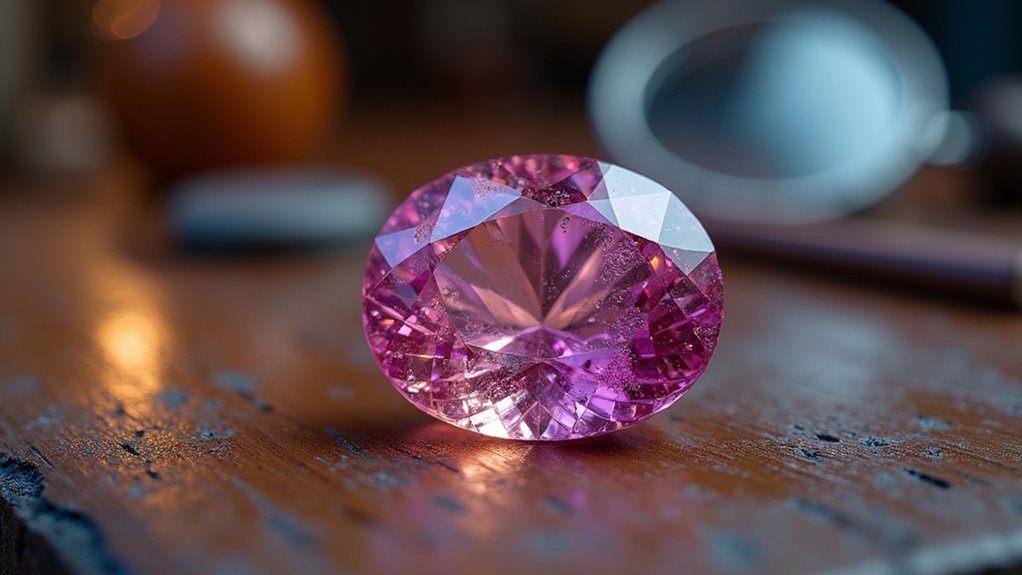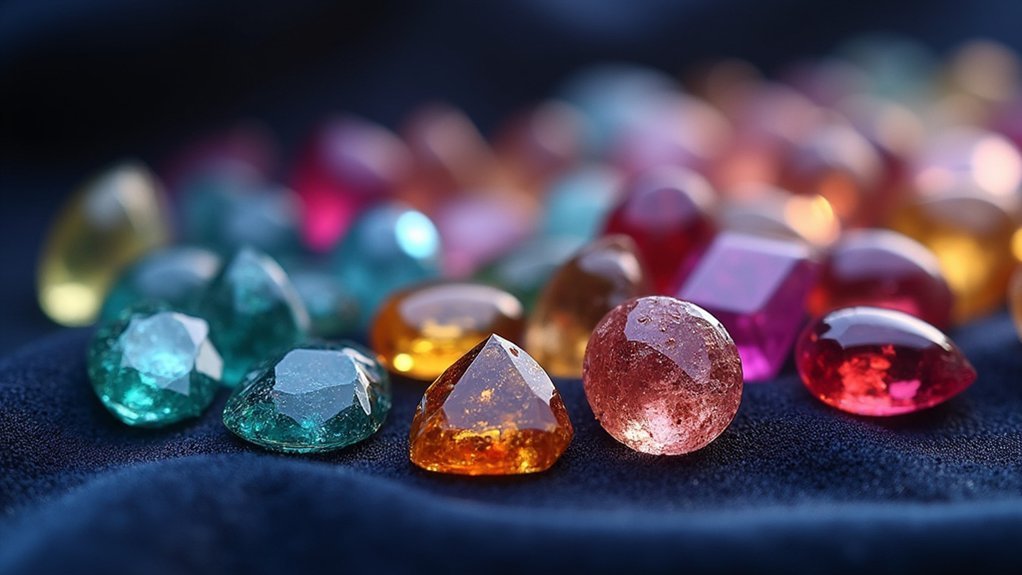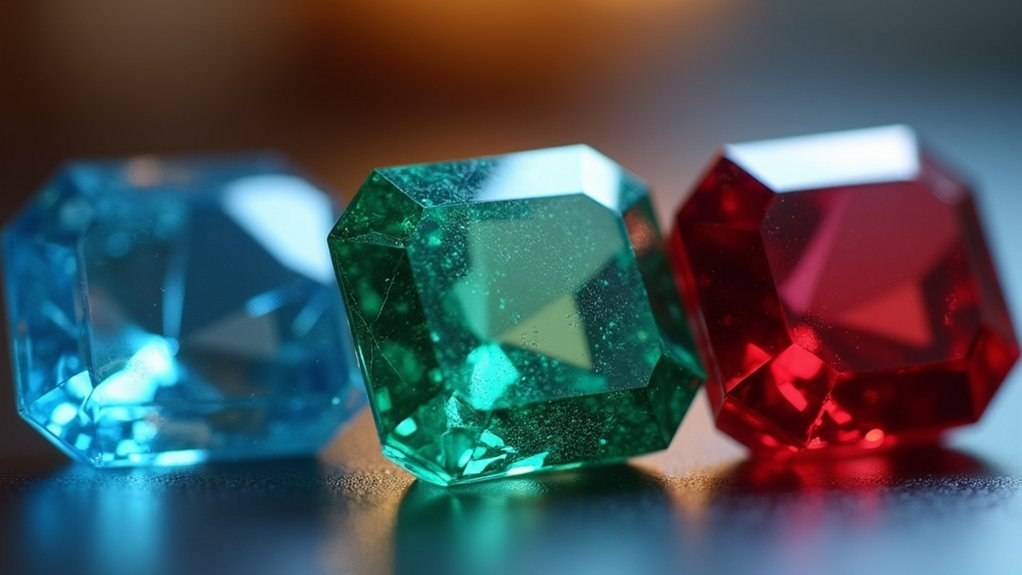When buying clarity enhanced gemstones, you’ll need proper certification from labs like GIA that disclose all treatments. Understand that enhanced stones cost 20-50% less than natural ones but require special care—avoid ultrasonic cleaning and use only mild soap. Research the enhancement method’s permanence since some treatments fade over time. Choose reputable dealers with complete transparency about treatments and written documentation. Verify the stability and durability ratings for your specific enhancement type. The following guidance reveals additional strategies for maximizing your investment.
Understanding Clarity Enhancement Methods and Their Impact

When you’re shopping for gemstones, you’ll often encounter clarity-enhanced stones that have undergone various treatments to improve their appearance and reduce visible flaws.
These enhancements include oiling and filling to minimize inclusions, laser drilling to remove imperfections, and dyeing to enhance color. While these methods make treated gemstones more affordable than untreated ones, you must understand their impact on long-term value and durability.
Treatment methods like oiling, laser drilling, and dyeing reduce gemstone costs but significantly affect their long-term value and structural integrity.
When buying a gemstone, you’ll need to take into account that some enhancements are permanent while others are temporary, affecting care requirements.
Transparency from sellers is essential – always request gemstone certification that discloses all treatments. This information helps you make informed decisions about pricing, maintenance needs, and whether the enhanced clarity meets your expectations for both immediate appeal and future investment potential.
Verifying Treatment Disclosure and Certification Requirements
Every clarity-enhanced gemstone purchase requires proper documentation to protect your investment and guarantee you’re getting what you pay for. You must demand transparency in the sale by requesting complete disclosure of all gemstone enhancements from your seller.
Reputable dealers should provide gemstone certification from an accredited gemological laboratory like GIA or AGS, which verifies the clarity grade and documents specific treatments applied to your clarity enhanced gemstone.
Always confirm whether treatments are permanent or temporary, as this affects both value and care requirements. The certification should detail enhancement methods and their stability.
Don’t accept verbal assurances—insist on written documentation. Compare prices between treated gemstones and untreated alternatives to ascertain fair pricing.
Evaluating Long-Term Stability and Durability Concerns

You’ll need to assess how permanent your gemstone’s enhancement is, since some treatments like heat are stable while others like oiling require ongoing maintenance.
Understanding the specific care requirements helps you determine whether you can handle the long-term upkeep and associated costs.
The enhancement’s stability directly impacts your stone’s future value and performance, so it’s vital to factor these durability concerns into your purchase decision.
Treatment Permanence Assessment
Before investing in a clarity enhanced gemstone, you must evaluate whether the treatment will remain stable over decades of wear. Treatment permanence directly affects your gemstone’s long-term value and appearance.
While some enhancements like HPHT and laser drilling are permanent, others may fade or deteriorate without proper maintenance.
You’ll need proper documentation to understand each treatment’s stability expectations. Request certificates detailing the specific methods used and their durability ratings. This information helps you make informed decisions about care requirements.
- Permanent treatments: HPHT and laser drilling typically maintain the gemstone’s clarity indefinitely
- Temporary enhancements: Dyeing and certain fillings may require reapplication or special handling
- Documentation verification: Always obtain certified reports confirming treatment methods and expected longevity
Understanding these factors protects your investment and guarantees lasting beauty.
Care Requirements Analysis
Since clarity enhanced gemstones require specialized maintenance protocols that differ markedly from untreated stones, you must develop an extensive care strategy that accounts for each treatment’s specific vulnerabilities.
Your care requirements depend heavily on the enhancement method used—oiled or filled stones need protection from heat and chemicals that could compromise treatments. You’ll need gentle cleaning with mild soap and soft cloths, avoiding ultrasonic cleaners that damage enhancements.
Regular inspections help detect deterioration requiring reapplication of treatments. Enhanced stones are vulnerable to scratching more than durable gemstones, demanding careful handling and storage.
Understanding long-term stability is vital since some treatments aren’t permanent, affecting your investment’s durability and requiring ongoing maintenance commitments.
Value Retention Factors
Market forces greatly impact the value retention of clarity enhanced gemstones, with permanence serving as the primary determinant of long-term investment potential.
You’ll find that enhancement methods like oiling or resin filling can compromise durability over time, affecting your gemstone’s market value. Understanding the specific treatment used helps you assess long-term stability accurately.
When evaluating value retention factors, consider these essential elements:
- Enhancement permanence – Temporary treatments may degrade, reducing both durability and resale value
- Certification requirements – Documentation from reputable gemological laboratories validates treatment methods and expected longevity
- Market acceptance – Research how different enhancement methods affect buyer perception and pricing in your target market
Making informed decisions requires investigating each gemstone’s clarity habits and how specific enhancements impact that particular variety’s long-term performance.
Comparing Enhanced Vs Natural Gemstone Values

When you’re deciding between enhanced and natural gemstones, understanding their value differences becomes vital for making an informed purchase. Clarity enhanced gemstones typically cost 20-50% less than natural gemstones, but this discount varies considerably based on treatment history and certification details.
| Factor | Enhanced Stones | Natural Gemstones |
|---|---|---|
| Initial Price | 20-50% lower | Premium pricing |
| Resale Value | Lower retention | Higher retention |
| Market Demand | Limited appeal | Strong demand |
| Certification Impact | Essential for value | Enhances premium |
Your stone’s treatment method affects pricing differently—oiling in emeralds reduces value more than heat treatment in sapphires. Natural gemstones with higher clarity grades command premiums, while enhanced stones struggle with resale value once treatments are disclosed, making certification absolutely vital for future transactions.
Assessing Special Care and Maintenance Needs
Unlike natural gemstones that tolerate standard jewelry care routines, clarity enhanced stones demand specialized maintenance protocols that directly impact their longevity and appearance.
You’ll need to understand specific care requirements for your clarity enhanced gemstones to preserve their beauty and value.
When cleaning these stones, you should use only mild soap and water. Avoid ultrasonic cleaners and steam cleaning, as these methods can damage the enhancements.
You must regularly check your gemstones for signs of deterioration or enhancement loss that naturally occurs with wear.
Essential maintenance practices include:
- Protecting stones from extreme temperatures and harsh chemicals that compromise treatments
- Scheduling periodic re-treatments for oiled or filled gemstones to maintain clarity
- Consulting your jeweler about specific enhancement methods and their unique care protocols
Choosing Reputable Dealers for Enhanced Gemstones

How can you guarantee you’re purchasing clarity enhanced gemstones from trustworthy sources who’ll protect your investment and provide accurate information? Start by seeking reputable dealers who provide detailed information about enhancement processes and their impact on the gemstone’s value. Look for certification from recognized laboratories like GIA or AGS, ensuring transparency about gemstone characteristics and treatments applied.
| Dealer Quality | Certification | Treatment Disclosure |
|---|---|---|
| Excellent | GIA/AGS certified | Complete transparency |
| Good | Some certification | Partial disclosure |
| Poor | No certification | Hidden treatments |
| Unethical | False documents | Misleading information |
Research dealer reviews to verify ethical sourcing practices and customer satisfaction. Engage dealers in conversations about enhancement methods and care requirements—knowledgeable sellers willingly share this essential information for informed purchasing decisions.
Determining Quality Standards for Different Enhancement Types
After establishing a relationship with a trustworthy dealer, you’ll need to evaluate the specific enhancement type used on your gemstone since each treatment method comes with distinct quality standards and market expectations.
Understanding whether your stone is treated or enhanced affects its quality and beauty assessment. Different treatments impact gemstone clarity differently – oiling emeralds is widely accepted, while laser drilling may reduce value considerably.
When buying gemstones, consider these enhancement evaluation factors:
- Permanence – Verify if treatments require special maintenance or may fade over time
- Market acceptance – Research how specific enhancements affect resale value for your gemstone type
- Visibility – Assess whether visible inclusions remain noticeable despite treatment affecting the gemstone’s color
Certification from the Gemological Institute of America provides peace of mind regarding treatment disclosure and quality standards.
Frequently Asked Questions
What Is a Clarity-Enhanced Gemstone?
You’re looking at a natural gemstone that’s been treated to improve its appearance by reducing visible inclusions and blemishes. These treatments make the stone look clearer but can affect its value and durability.
How Can You Tell if a Gemstone Is Good Quality?
You’ll want to examine the gemstone under 10X magnification for inclusions, verify it’s eye-clean, check for reputable lab certification, ask about treatments, and compare clarity against similar stones.
What Are the Grades of Gem Clarity?
You’ll find gem clarity grades range from Internally Flawless (IF) at the top, through Very Very Slightly Included (VVS), Very Slightly Included (VS), Slightly Included (SI), to Included (I) at the bottom.
What Are the 4 C’s of Gemstones?
You’ll evaluate gemstones using four criteria: Cut determines how well it’s shaped for brilliance, Color assesses hue and vibrancy, Clarity measures inclusions and blemishes, and Carat indicates weight and size.
In Summary
You’ll make smarter purchasing decisions when you understand enhancement methods, verify proper disclosures, and assess long-term durability. Don’t forget to compare values between enhanced and natural stones while considering special maintenance requirements. Choose reputable dealers who’ll provide complete treatment information and proper certification. Remember that different enhancement types have varying quality standards, so you’ll need to evaluate each stone individually. With these tips, you’re ready to confidently buy clarity enhanced gemstones.




Leave a Reply